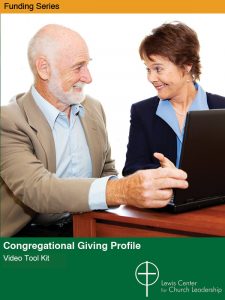Many churches struggle with finances due to a lack of financial understanding rather than insufficient funds. Effective financial tools and knowledge are crucial. Thomas James shares how to learn about your church’s financial culture using the Lewis Center’s updated Congregational Giving Profile (CGP) that tracks income, expenses, and trends, aiding churches in making informed decisions and improving financial management.
Are your finances a mess? Of course they are, you’re a church.
Over the past 20 years of ministry, I have found few exceptions to this corny joke. The problem for most churches isn’t that they don’t have enough money, though few churches would turn down an increase in congregational giving. Instead, the problem for many churches is their lack of financial understanding. Churches need better tools to facilitate financial systems, and they need a more reliable understanding of their income and expenses.
Improvements in financial software and online systems can streamline many financial functions, and more efficient tools can lessen the work required of volunteer and paid treasurers, financial secretaries, and bookkeepers. But beyond implementing new systems and structures, simply having better knowledge of your financial forecast can lead to more well-informed conversations around important ministry decisions.
Churches have a financial culture.
Every church has a unique pattern of giving that ebbs and flows around the life of the community. No church receives contributions equally throughout the year, not even churches with a high percentage of recurring online givers. Some churches serve in communities where tithes and offerings are only given in response to an end-of-the-month paycheck. Some churches rely on pre-paid pledges to build a cushion in the bank account at the start of a new fiscal year. Many churches see a bump in giving, often corresponding with an increase in physical attendance, around the Advent and Christmas seasons.
While your church’s giving may go through peaks and valleys throughout the year, there’s a high likelihood that your giving patterns remain consistent from year to year. It’s estimated that it takes 2-3 years to change a culture with intentional efforts, so even if you’re actively trying to change your congregation’s giving patterns, you can expect that a multi-year assessment of past contributions will provide a reliable expectation for the year to come.
Just as your church has unique patterns of giving, it’s also likely to have a consistent pattern of expenses. You may find many expenses are evenly divided throughout the 12 months of the year (i.e., apportionments or mission share, salaried payroll, monthly insurance installments, etc.), but many expenses vary based on seasonal changes. Mission trip related expenses may increase when school is out in the summer. Gas bills may increase in the winter to provide additional heat in the building. Some subscriptions may be billed annually, causing odd jumps in a single month’s expenses.
While your expenses may have dips and spikes throughout the year, there’s a high likelihood that your pattern of expenses remains consistent from year to year. By using a multi-year average, you can reasonably predict how much you will spend each month during the year.
Tracking giving and expenses well
Nearly 15 years ago, I served on the staff at the Lewis Center for Church Leadership when the Congregational Giving Profile (CGP) was first launched as a tool to help churches track their congregational income. I can still hear the voice of Rev. Dr. Lovett H. Weems explaining the tool, its purpose, and offering his own pastoral experiences with finance committee members who would be banging on his door at the end of the summer in a feverish concern for how the church would be able to pay its bills following the decreased giving of June and July.
I’ve now used the Congregational Giving Profile in my own pastoral leadership over the past decade, and it has become one of the primary tools I use for narrating the ebbs and flows of the church’s financial life with finance committees, administrative boards, and concerned congregants. CGP has provided a reliable financial forecast to guide decision making throughout the year.
Reimagining the Congregational Giving Profile
This July, I was appointed to an extension ministry, which has allowed me to launch a new company, Ekklesia Financial Services, focused on helping churches clean up their messy financials (see below for more information). The Congregational Giving Profile is a key component to helping churches better understand their finances.
In my years serving in the local church, I tweaked the CGP for my own use with input from colleagues and finance teams. Over the past year, I worked with the Lewis Center staff to reimagine the Congregational Giving Profile and update the tool to provide a more visually-accessible grasp of your church’s finances.
The new Congregational Giving Profile includes both income and expenses and allows you to track both regular contributions and other non-regular streams of revenue (rental income, grants, refunds, etc.). The new CGP template uses three years of past giving and expenses, along with your current year’s budget, to calculate a printable Monthly Results page that includes both numerical and graphical charts to help you track your congregation’s giving and expenses. Your church finances may never look just as you imagine, but using the updated and improved Congregational Giving Profile can give you the confidence you need to make faithful ministry decisions.
Ekklesia Financial Services offers financial services designed to lessen the headache that is church finances and to provide churches with reliable financial reports to guide important ministry and missional decisions.
 Related Resources
Related Resources
- Congregational Giving Profile, a Lewis Center video tool kit resource
- Developing Your Operating Budget, a Lewis Center video tool kit resource
- A Transformative Approach to Church Finances featuring Lovett H. Weems Jr. and Ann A. Michel — Listen to the Leading Ideas Talks podcast episode | Read the transcript
- Models for Budget Building by Lovett H. Weems Jr.






